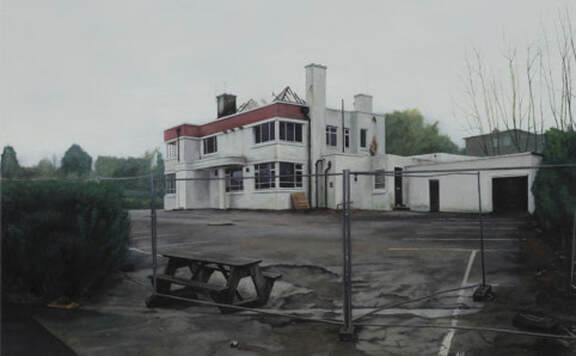|
George Shaw, The Age of Bullshit (2010)* "I paint the paintings of all the times and all the thoughts I lack the language to describe." George Shaw 1. In 1980, my friend David Morgan took me on a pub-crawl around Liverpool to show me the historical bar interiors. From the hand-carved ornamentation above the polished bars to the paneling, from the ceilings to the chairs, stools, and doors, he pointed out the signs of expert craftsmanship. Liverpool had been a great ship-building city and when a ship was finished, and before work on the next had begun, various woodworkers, cabinet makers, carvers, and other outfitters turned to fitting out pubs. The same exotic woods that went into the interiors of the most expensive yachts, the same elaborate ornamentation, and the same classic stained-glass panels and brass fittings, all found their way into designing and building the City’s most famous and beautiful public houses. the painting’s detail contradicts destruction by heavy machinery of the portico’s precision its fervent, modernist lines made from a photo he’d taken himself, details so awfully exact it’s perfect - but something’s not right, like the eyes of the dead in Italian cemeteries like the flat darkened windows in this abandoned building, the dead stare outwards looking but not seeing us 2. They came with bulldozers on trucks to the orange groves in the town where I grew up and, after marking the boundaries with wooden laths with red ribbons attached, they dragged the navel orange trees out by their roots, piled them in the centre of the naked fields, and set them on fire. They erected chain-link fences all around, as if it were a construction site rather than the scene of devastation, and then, when the bulldozing and burning were done, they flattened and leveled the ground. Before long, they were pouring concrete foundations and erecting pre-fabricated two-by-four walls and nailing on the sheet-rock lathing. Last came the plasterers to slather on the stucco in pastel pinks, yellows, and pale blues. walking through the streets in each new development I imagined orange blossoms, as their scent had been heavy and thick in the air what do the words mean when we say that time and space elide? Is it that the stones crack, erode, crumble, and crash back into the past? when the walls were just an idea, the rock not yet quarried, nor plaster mixed, when the first horse-drawn plow carved groves out of the desert? 3. There is mystery surrounding ruins, ghosts in the unused residue of what was once vital and active. When we look now at chateau ruins in the hills of southern France, time seems to be measured only in decay and disuse. But, in the middle of a busy street in Rome, I looked down into a great hole in the highway, a deliberate hole with elaborate railings all around. Below, and visible from above, were layers of Roman civilization measuring time in physical space, layers of time, like the rings in an ancient fallen tree. inevitably time calculates destruction as entropy’s force slows the atoms of the world to a snail’s pace. Death lingers with its cold sameness nothing’s left but memories and things die under their own weight making them masks blackened icy eyes stare back it begins to die death drifts from unused chimneys a glazed mourning shroud painted so deftly you know the perfect thing has perished. Charles D. Tarlton * Shaw’s own title for this painting of the Hawthorn Tree, once a pub on the Tile Hill Housing Estate outside Coventry where George Shaw grew up. There are three Shaw paintings of the pub – one when it seems still to have been operating, this one after a fire that destroyed the roof, and a third that shows a mass of rubble behind a chain-link fence, rubble left after the pub was torn down.
0 Comments
Your comment will be posted after it is approved.
Leave a Reply. |
The Ekphrastic Review
COOKIES/PRIVACY
This site uses cookies to deliver your best navigation experience this time and next. Continuing here means you consent to cookies. Thank you. Join us on Facebook:
July 2024
|




